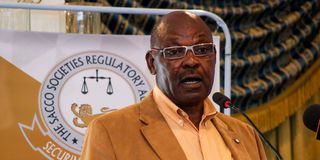Broke Kenyans withdraw Sh30.8 billion savings from saccos

Sacco Societies Regulatory Authority (Sasra) chairperson Jack Ranguma during the Sacco Central (Shared Services) annual delegates meeting at Sarova Stanely Hotel in Nairobi on April 15, 2023.
What you need to know:
- Withdrawable deposits (also known as Fosa savings), which are usually held by Saccos as demand deposits, also fell by 26.9 per cent to Sh83.78 billion from Sh114.59 billion.
Kenyans last year cashed out Sh30.8 billion of the money they saved in savings and credit cooperative societies (Saccos) as economic hardships characterised by the rising cost of living pushed them to the brink.
Latest figures from the Sacco Societies Regulatory Authority (Sasra) show that withdrawable deposits (also known as Fosa savings), which are usually held by Saccos as demand deposits, fell by 26.9 per cent to Sh83.78 billion from Sh114.59 billion.
"This can be attributed to the high cost of living, which resulted in members withdrawing their savings for consumption purposes," Sasra said in its latest supervisory report.
"The harsh macroeconomic conditions that prevailed for most of 2022, such as high inflation and exchange rates and drought, resulted in a significant reduction in disposable income for the majority of Sacco members, which led to low voluntary savings."
This was the second year in a row that savers were dipping into their savings. Sacco savers had withdrawn Sh10.46 billion the previous year, reducing Fosa savings in Sasra supervised Saccos from Sh12.05 billion.
Fixed deposit savings also fell by Sh1.31 billion from Sh22.33 billion to Sh21.02 billion during the period. Sasra sees the elevated inflation affecting members' ability to save more money this year, which may force some Saccos to borrow to fund members' borrowing appetite.
"The high inflation and interest rates projected to persist in 2023 are likely to reduce the savings propensity of members of Saccos, thereby undermining the ability of Saccos to mobilise savings from members, while expensive external borrowing has the potential to increase their cost of doing business," said Mr Jack Ranguma, the chairman of Sasra.
The decline in withdrawable and fixed deposit savings during the period of economic challenges also saw the number of dormant members in deposit-taking (DT) and non-withdrawable deposit-taking (NWDT) saccos rise from 1.18 million to 1.22 million.
Sasra defines dormant members as those who had not made any financial transactions with their respective saccos for a period of six and 12 months for DT and NWDT saccos, respectively, before the end of last year. The consecutive decline in voluntary savings contrasts with 2020, when such savings increased by 85.3 per cent to peak at Sh125.5 billion.
Sasra says the increase in voluntary savings despite the Covid-19 disruptions was influenced by the government's economic incentives, including tax waivers, which eased economic hardships and increased people's propensity to save.
Overall, total savings in Sasra-regulated saccos grew 9.84 per cent to Sh620.45 billion at the end of last year from Sh564.89 billion a year earlier.
The growth in deposits was supported by non-withdrawable deposits, also known as Bosa savings, which grew by 20.5 per cent to Sh515.65 billion, accounting for 83 per cent of total deposits.
"The increase in Bosa savings can be explained by the fact that they are mandatory in nature while Fosa savings are voluntary and easily accessible by members in case of need," said Sasra.





